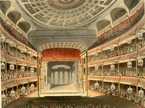EN | CS | SK | SI | PL | DE
history of the theatresupplementtechnical dataHistoric equipmentRoyal Opera House
alias Theatre Royal in Covent Garden, Royal Italian Opera, Royal OperaCovent Garden, | Wikipedia, History, rohcollections.org.uk, arthurlloyd.co.uk |
| show on the map | http://www.roh.org.uk/ |
Important events
(detail)7.12.1732 | Opening of the first theatre
Opened a revival of The Way of the World by William Congreve with a capacity of 1897 seats.
(detail)18.9.1809 | opening of the 2nd theatre
Opened with Macbeth, preceded by an occasional address spoken by John Philip Kemble, followed by The Quaker, a musical entertainment by Charles Dibdin with a capacity of 3000 visitors.
(detail)15.5.1858 | opening of the third theatre
Opened with Les Huguenots by Meyerbeer with a capacity of 2190
spectators.
People
Edward Middleton Barry |architect
Henry Holland |architect
John Inigo Richards |architect
John Rich |architect
Edward Shepherd |architect
Robert Smirke |architect
John Flaxman |sculptor
History
Additional information
No information has yet been entered
Add information

















































